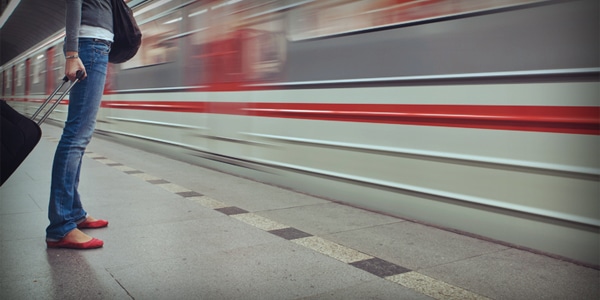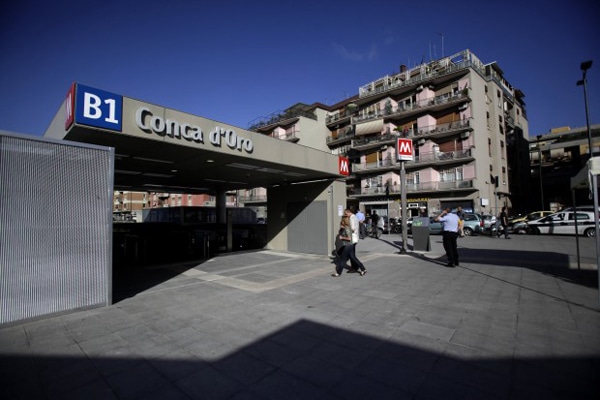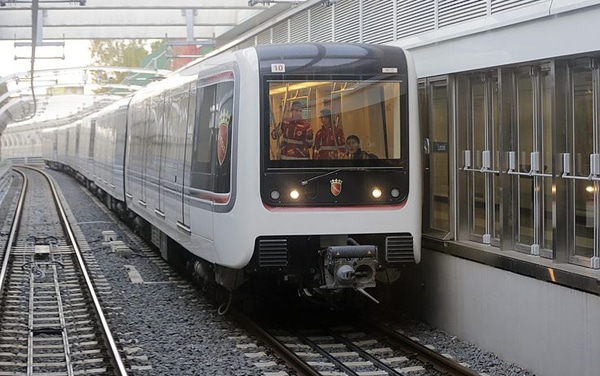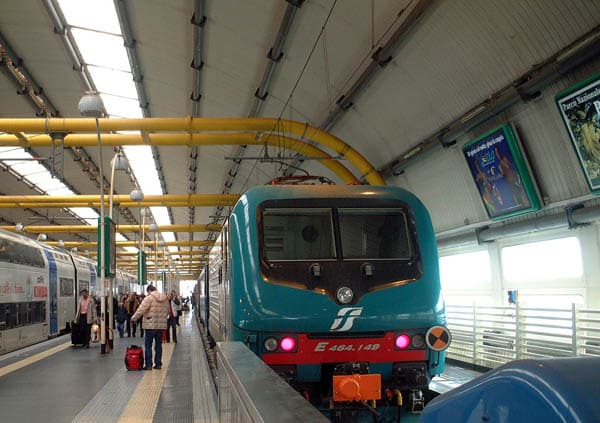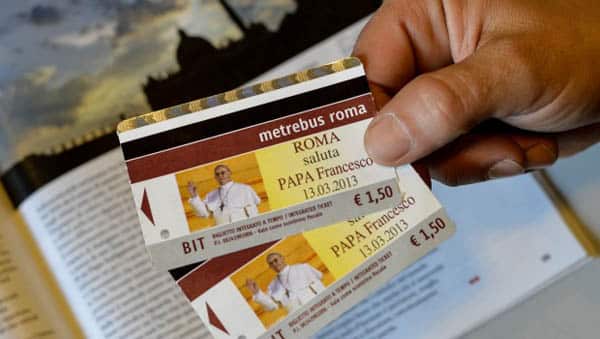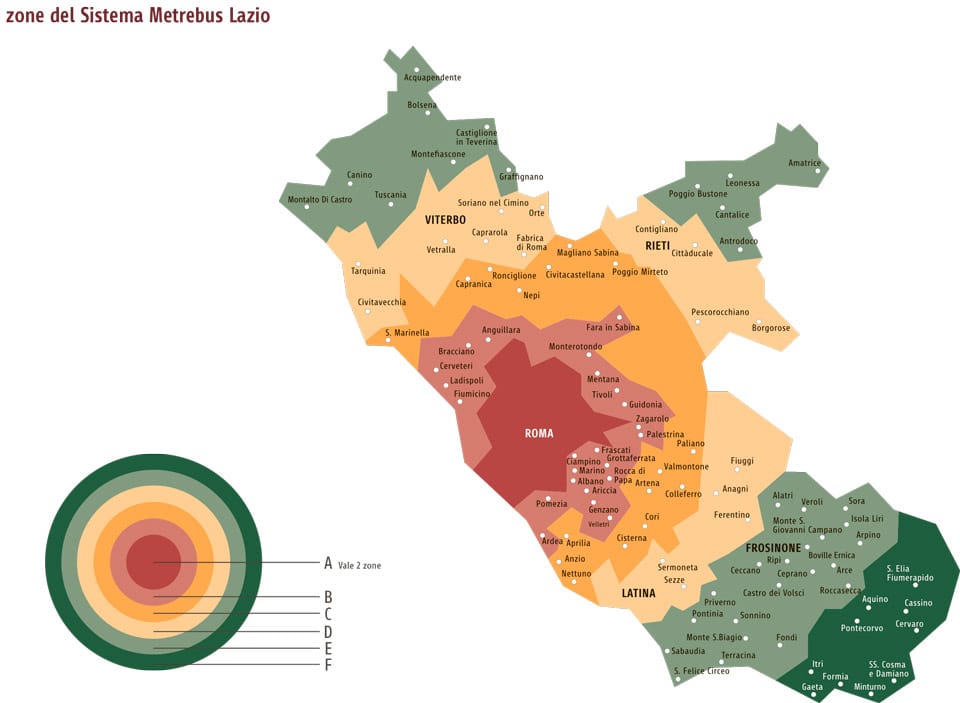The Roman Metro (Metropolitana di Roma) – is the youngest in Europe, only 60 years old. Metro in rome is not as ramified as the Barcelona subway, and its length is three times less than the London subway, but the scheme is almost as strict and logical as the Moscow one. This is a very convenient and popular form of public transport in the Eternal City. By 2023, passenger traffic exceeded 270 million people.
Page Contents
What does the metro system in Rome include?
The metro of the Eternal City (Metropolitana di Roma) includes classic underground lines and surface electric trains. The state ATAC company operates them. It is convenient for passengers: one ticket is valid for all types of transport. Its price depends on a tariff zone, and you can buy a pass everywhere, even in kiosks selling cigarettes.
Map
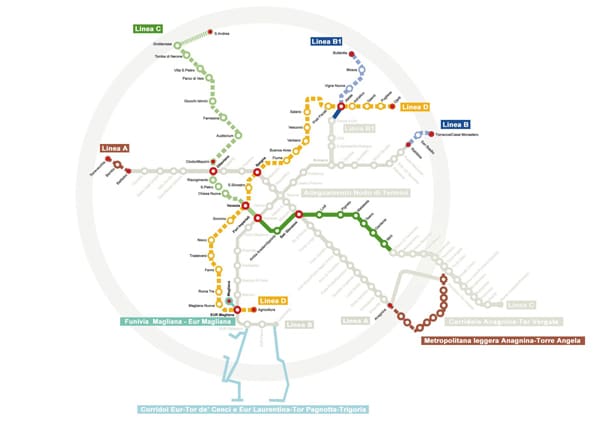
Download Rome metro map (.pdf in good quality)
The metro map of Rome is quite simple. Don’t check the English version because the transcription of Italian titles will not give you anything. One can easily travel between tourist attractions without knowing the Italian language – all the stations near which they are located have the same names. Want to see the Colosseum?? Go to Colosseo (blue li e). Metro lines are marked as red squares with letter ‘M’ on a city and Google maps.
The scheme of the Roman metro is simple, it is oriented in space in the same way as the stations are located on the ground. Fiumicino Airport is located in the southwest, so you should look for it on the diagram in the lower left corner.
Line B (Linea B)
The oldest line of the Roman Metro is B line, it is marked in blue.
Development of the project began in 1940, but construction began only in 1948 and was completed in 1 55. It has 22 stations, and the line crosses the city from southwest to northeast. The terminal stations are ‘Rebibbia’ and ‘Laurentina.’
Line A (Linea A)
Orange Line A was built from 1955 to 1980.
It has 27 stations – from the terminal ‘Batistini’ in the northwest to ‘Anagnina’ in the southeast. Оранжевая и The Orange and Blue lines intersect at Termini station, where you can change the trains.
Line Chi (Linea C)
The third line of the “subway” is green, it was launched only in 2012.
By 2023, it will have three platforms. The line promises to be the most convenient for traveling between attractions. According to the scheme, there are intersections with A and B lines in the area of ‘S. Giovani’ and ‘Colosseo’ stations. Thus, the Chi line will pass under the Roman Forum, and a separate exit will be built to it. Stops on this line will become underground museums.
Ground electric trains
Rome has 11 electric train lines, 3 of them are city trains, following the directions of Roma Lido, Roma Giardinetti and Viterbo (Roma Nord).
Tourists are more interested in suburban electric trains, the lines of which are designated as FR -8. It is they who deliver to the new Fiumicino airport (FR1 line) and the old one – Ciampino FR6 line.
You can take a train at FR1 line to Fiumicino Airport:
- Tiburtina station – travel time 47 minutes;
- Trastevere – travel time 27 minutes;
- Ostiense station – travel time 32 min.
There is a station of the same name on the blue line B near the Tiburtina train stat on. You can also change the lines at Piram da. Next to it is the Ostiense station, from where trains start on the Roma Lido line towards the sea (the beaches are located at the last three stations: from Lido Centro to Cristoforo Colombo).
Ticket prices and Timetable
The Roman ticket gives you the right to use all types of public transport. Its price depends on the tariff zones, but the entire territory of the municipality of Rome is located in the first one A. So, the price is the same wherever you go within the c ty. The most common ‘one-time’ type of ticket (BIT) costs 1.5 Euros in 2019.
Remember: having bought such a ticket, you can use any bus or a tram within the boundaries of zone A, within 100 minutes after composting and change the type of transport if needed within given time frame.
But, leaving the subway or deciding to change the direction of traffic for a railway station, you will have to pay for the fare again. Children under 10 years old travel free of charge.
- Read about how to travel with children in Rome.
On 1 March 2015, a new public transport ticket system was launched in Rome. Tickets options:
- Roma 24 – valid for 24 hours a day from the moment of their marking, price – 7 Euros;
- Roma 48 – valid for 48 hours, price – 12.5 Euros;
- Roma 72 – valid for 72 hours, price – 18 Euros;
- CIS – valid for seven days, price – 24 Euros.
New tickets allow you to make an unlimited number of trips on public transport: buses, trams, metro, suburban trains for the time period indicated on the ticket.
- Important: Public transport tickets are not valid for trains and buses to Fiumicino Airport.
The line to Fiumicino Airport operates from 5:00 to 23:27, and trains run every 15 min. on weekdays and every 30 min. on holidays. A ticket to the airport costs 8 Eu os. Alternatively, the direct Leonardo express train without stops costs 14 Euros and departs every 30 min. from Termini station.
Check instructions:
- How to get from Fiumicino Airport to Rome
- How to get to the Vatican
- How to get to the sea from Rome for 1.5 Euro
Underground opens to passengers on weekdays from 5:30 a.m. Closing time depends on the day of the week. On Fridays and Saturdays, this happens an hour later: not at 23:30 as usual, but at 00:30. City trains to Giardineti and Viterbro finish work at 23:00, and to Lido direction at 00 00. The rule of Fridays and Saturdays applies to them as well.
Rome public transport tickets are sold in strictly limited locations. The safest way to buy a travel card is at major hubs, at ticket machines at the entrance to a metro station, and at tobacco kiosks. Until the ticket is validated, the time is not counted. Therefore, you can buy tickets right at the airport so that, having settled in a hotel, you can immediately head for a walk around the Eternal City.
- Official website of the Roman Metro: www.romametropolitane.it
- Official website of public transport in Rome: www.atac.roma.it
The Transport System of the Lazio Region
The Lazio region is divided into seven transport zones. Rome includes two zones. For example, a trip from Rome to Anzio or Santa Marinella covers four zones, and from Rome to Ladispoli or Tivoli covers three zones.
To travel around Lazio zones, you can use the metro system and regional trains of the 2nd cl ss. There are one-day (BIRG), 3-day (BTR), and 7-day (CIRS) passes.
The CIRS weekly pass is suitable for travelers who plan to travel actively around the Lazio region by train. For just € 61.50, you can travel on all regional trains for a week without restrictions.
 Italy for me From Italy with love
Italy for me From Italy with love

